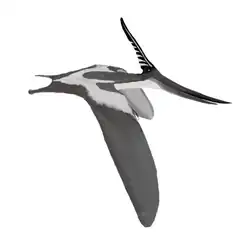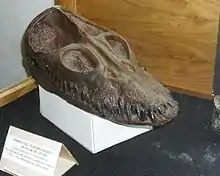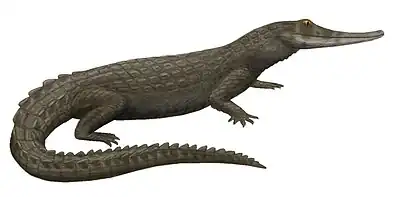Portal:Cretaceous
The Cretaceous Portal IntroductionThe Cretaceous (IPA: /krɪˈteɪʃəs/ krih-TAY-shəs) is a geological period that lasted from about 145 to 66 million years ago (Mya). It is the third and final period of the Mesozoic Era, as well as the longest. At around 79 million years, it is the longest geological period of the entire Phanerozoic. The name is derived from the Latin creta, "chalk", which is abundant in the latter half of the period. It is usually abbreviated K, for its German translation Kreide. The Cretaceous was a period with a relatively warm climate, resulting in high eustatic sea levels that created numerous shallow inland seas. These oceans and seas were populated with now-extinct marine reptiles, ammonites, and rudists, while dinosaurs continued to dominate on land. The world was ice- free, and forests extended to the poles. During this time, new groups of mammals and birds appeared. During the Early Cretaceous, flowering plants appeared and began to rapidly diversify, becoming the dominant group of plants across the Earth by the end of the Cretaceous, coincident with the decline and extinction of previously widespread gymnosperm groups. (Full article...) Selected article on the Cretaceous world and its legacies Artist's restoration of Pteranodon. Pteranodon was not a dinosaur. By definition, all dinosaurs belong to the groups Saurischia and Ornithischia, which exclude pterosaurs. Nevertheless, Pteranodon is frequently featured in dinosaur books and is strongly associated with dinosaurs by the general public. (see more...) Did you know?
Need help?Do you have a question about Cretaceous that you can't find the answer to? Consider asking it at the Wikipedia reference desk. Selected image
Selected article on the Cretaceous in human science, culture or economics.png.webp) A Marella fossil. Paleontology lies on the border between biology and geology. It now uses techniques drawn from a wide range of sciences, including biochemistry, mathematics and engineering. Use of all these techniques has enabled paleontologists to discover much of the evolutionary history of life, almost all the way back to when Earth became capable of supporting life, about 3,800 million years ago. As knowledge has increased, paleontology has developed specialized sub-divisions, some of which focus on different types of fossil organisms while others study ecology and environmental history, such as ancient climates. Body fossils and trace fossils are the principal types of evidence about ancient life, and geochemical evidence has helped to decipher the evolution of life before there were organisms large enough to leave fossils. (see more...) GeochronologyEpochs - Early Cretaceous - Late Cretaceous Landmasses - Baltica - Gondwana - Laurentia - Siberia Fossil sites - Beecher's Trilobite Bed - Walcott–Rust quarry Researchers - Charles Emerson Beecher - Charles Lapworth - Charles Doolittle Walcott Quality ContentFeatured Cretaceous articles - Bone Sharps, Cowboys, and Thunder Lizards - Bone Wars - Edward Drinker Cope - Geology of the Capitol Reef area - Geology of the Death Valley area -Geology of the Grand Canyon area - Geology of the Zion and Kolob canyons area Good Cretaceous articles - Chitinozoan - Coal ball - Dimetrodon - History of paleontology - Evolutionary history of life - Ornatifilum - Opabinia - Paleontology- Schinderhannes - Small shelly fauna - Temnospondyli - Tiktaalik - Waptia Subcategories Cretaceous Cretaceous by continent Cretaceous geochronology Cretaceous events Cretaceous geology Cretaceous life Cretaceous paleogeography Cretaceous stubs Things you can do
Current Cretaceous FACs - none currently Related contentAssociated WikimediaThe following Wikimedia Foundation sister projects provide more on this subject:
|

